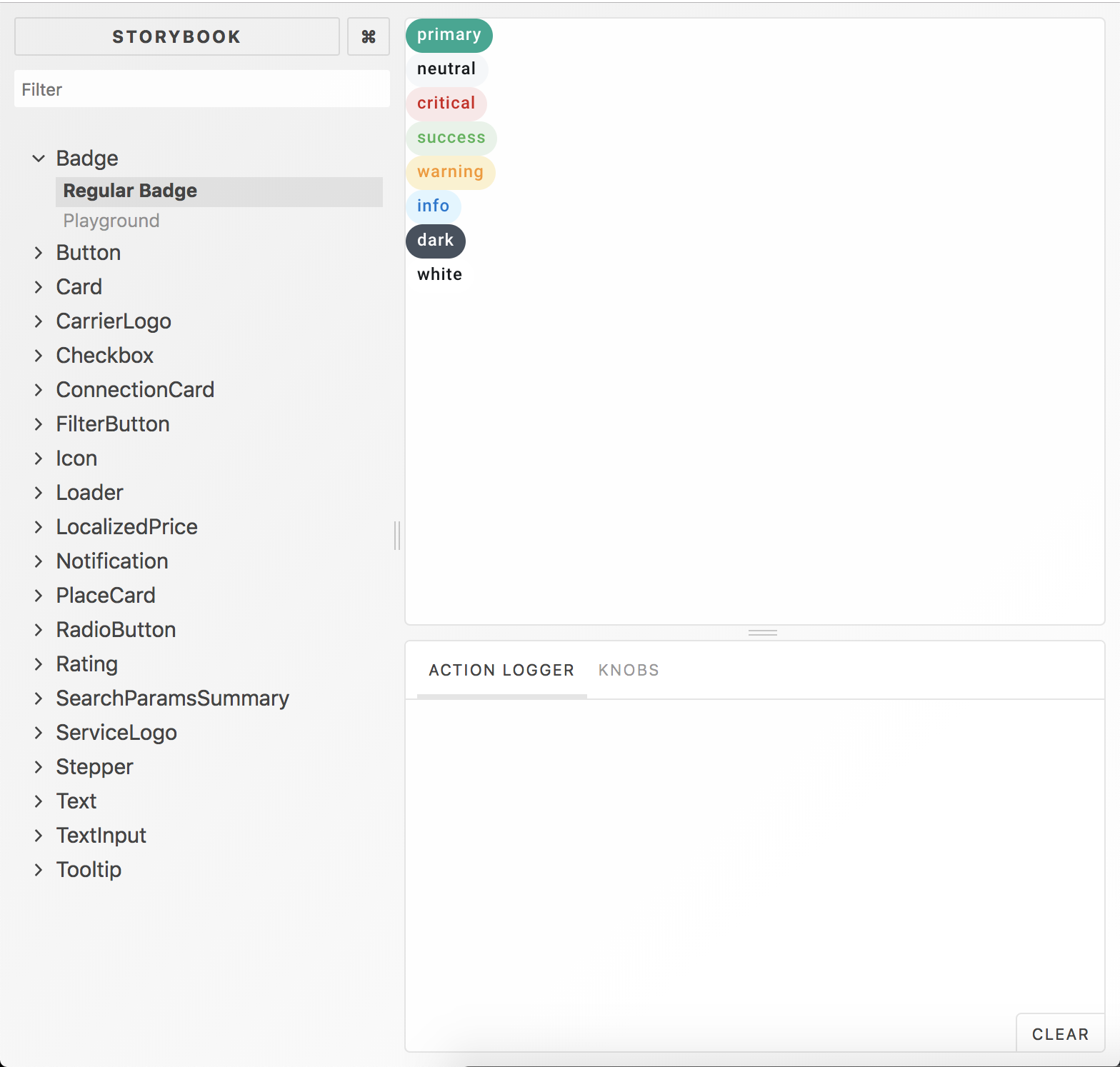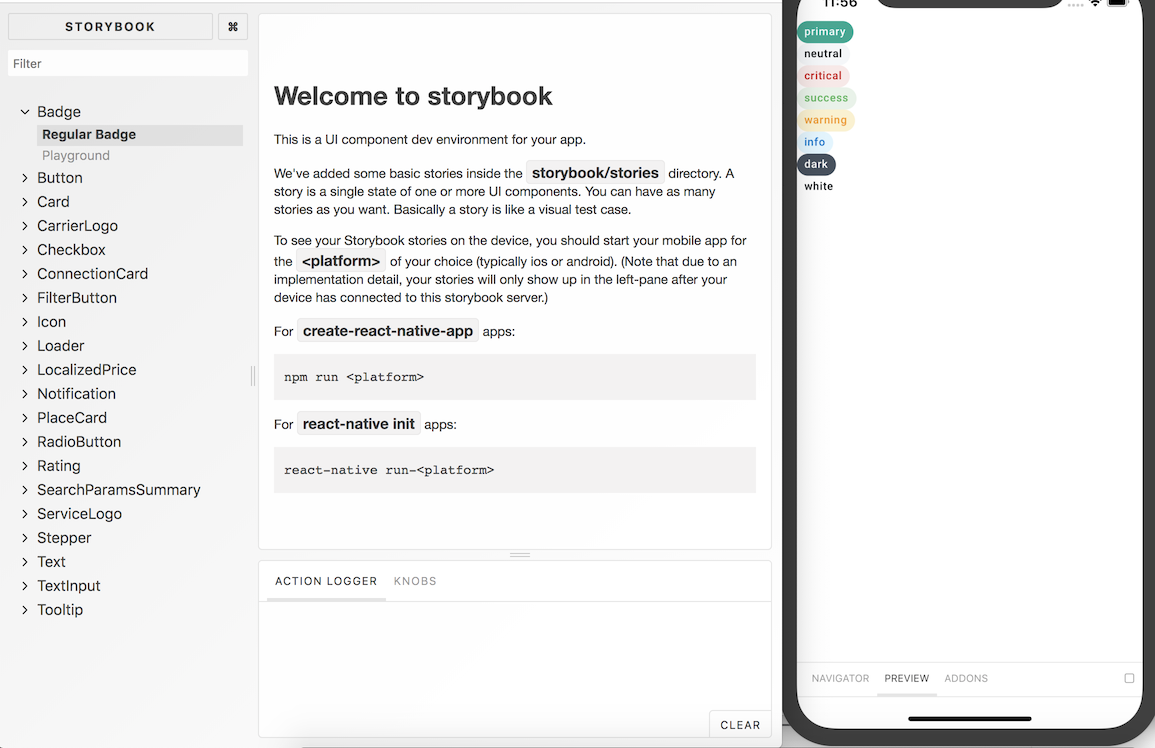Contributing guidelines - universal-components
Note: These guidelines assume you have an existing React Native setup on your machine and that your simulator/emulator is properly functionning. If not, have a look at Getting Started • React Native, and go to "Building Projects with Native Code".
Storybook
To run the storybook and start developing, clone the repository
git clone https://github.com/kiwicom/margarita.git
and enter the directory to install the node modules:
cd margarita
yarn
Desktop
If you want to see the web version, run
yarn storybook:web:universal-components
and you should go to http://localhost:9009 to see

Mobile
If you want to see the mobile version, run
yarn storybook:mobile:universal-components
Open Expo on your device/simulator and use the QR code or URL provided to access the Storybook.
Easier navigation
Although it is possible to navigate using the menu inside the mobile Storybook, there is a navigator inside the browser available at http://localhost:7007 after you run
yarn storybook:mobile:universal-components
You should see something similar to 
and it is then easier to test the interactions with the action logger, and play with the knobs inside the Playground.
Troubleshooting
I added
MyComponent.stories.jsand it is not available on iOS or Android in the storybook, but I can see it on the web version.
This is sometimes due to the fact thatreact-native-story-loaderdid not run. Kill the running process by pressing CTRL+C and run the Storybook again:yarn storybook:mobile:universal-componentsI started the web UI for the mobile storybook but no stories are displayed.
Make sure that the packager is running (yarn storybook:mobile:universal-components), and refresh the application by pressing CMD+R oniOSor by pressing R twice onAndroid. If you usePhysical device, you can refresh the application by shaking the device and pressing Reload.Android physical device
In case refreshing of the application didn't help, try to connect your phone via USB cable with enabled debugging and run
adb reverse tcp:7007 tcp:7007If you get permisson error check whether you correctly followed these instructions and that you set your USB mode to
File Transfer. Then try refreshing the application again.I modified some components in
packages/universal-componentsbut they are not updated in Margarita.
This is because the files which are resolved when importing anything from@kiwicom/universal-componentscome frompackages/universal-components/lib. Runyarn workspace @kiwicom/universal-components buildto create a new
libfolder with your latest changes.
Before submitting a PR: a checklist
- I tested my component at least on iOS or on Android;
- I wrote tests for my component and all tests are passing;
- I ran
yarn test-ciand there were no errors; - I squashed all my commits into one (unless having several really makes sense);
- I chose a descriptive message for all my commit messages (check commit message convention);
- I created my PR and added reviewers.
Commit message convention
Commit message should contain also proper description, once you open a PR it will be added automatically to PR description.
We prefix our commit messages with one of the following to signify the kind of change:
Fix: bug fixes, e.g. fix some colors, paddings.Feat: new features, e.g. add new component.Refactor: code/structure refactor, e.g. new structure folder for components/ extracting component to separate file.Docs: changes into documentation,Test: adding or updating tests, e.g. unit, snapshot testing.Chore: tooling changes, e.g. change circle ci config.BREAKING: for changes that break existing usage, e.g. change API of a component.
To make this easier, assuming you are at the root of margarita monorepo, please run the following command:
git config --local commit.template commit-template.txt
This will pre-fill your commit message with a template whenever you run git commit, reminding you to follow the convention and to add a summary.
Updating Icons
If you need to update the icon list (Icon/icons.json), make sure to run
node scripts/generateTypes.js
to update src/types/_generated-types/index.js. This ensures flow types are accurate.
Style Guide
Writing flow types in different files
When writing flow types, leave them as close to the component as possible, ideally in the same file. They should be written just after the imports and before the component declaration.
However, since this is a multi-platform component library, if some types need to be reused in different files specific to each platform, the accepted practice is to extract said types into a file ComponentTypes.js in the same Component folder. They would typically consist of Props and State types.
For instance, have a look at Checkbox. Since we have a
Checkbox.native.jsfile and aCheckbox.web.jsfile, we need to extract the common types intoCheckboxTypes.js. However,CheckboxShared.jsis a cross-platform component and it contains its types inside the same file.
If you need to import types in other components, the convention is to do the following:
import type { Props as ComponentProps } from "../Component/Component";
